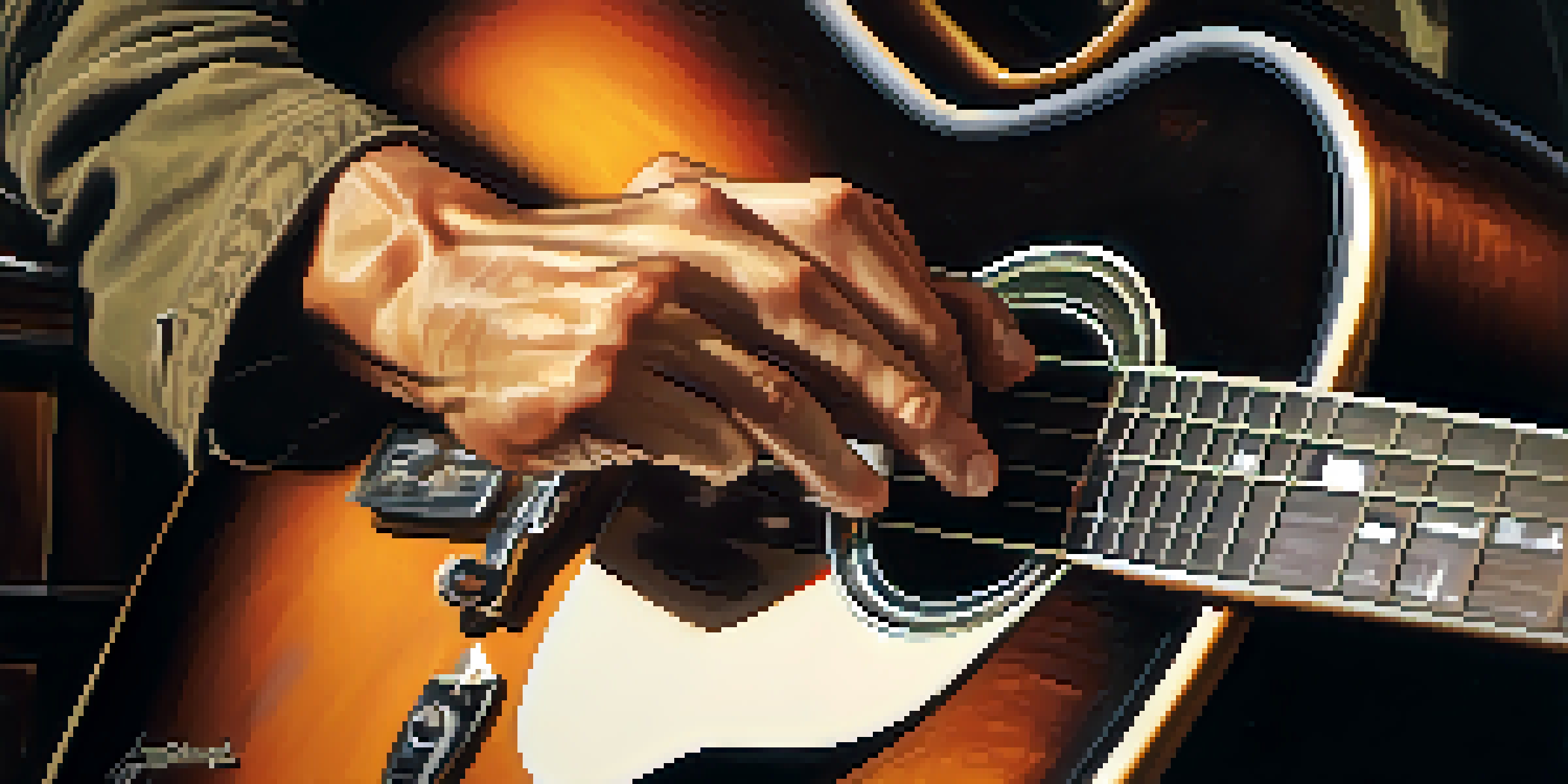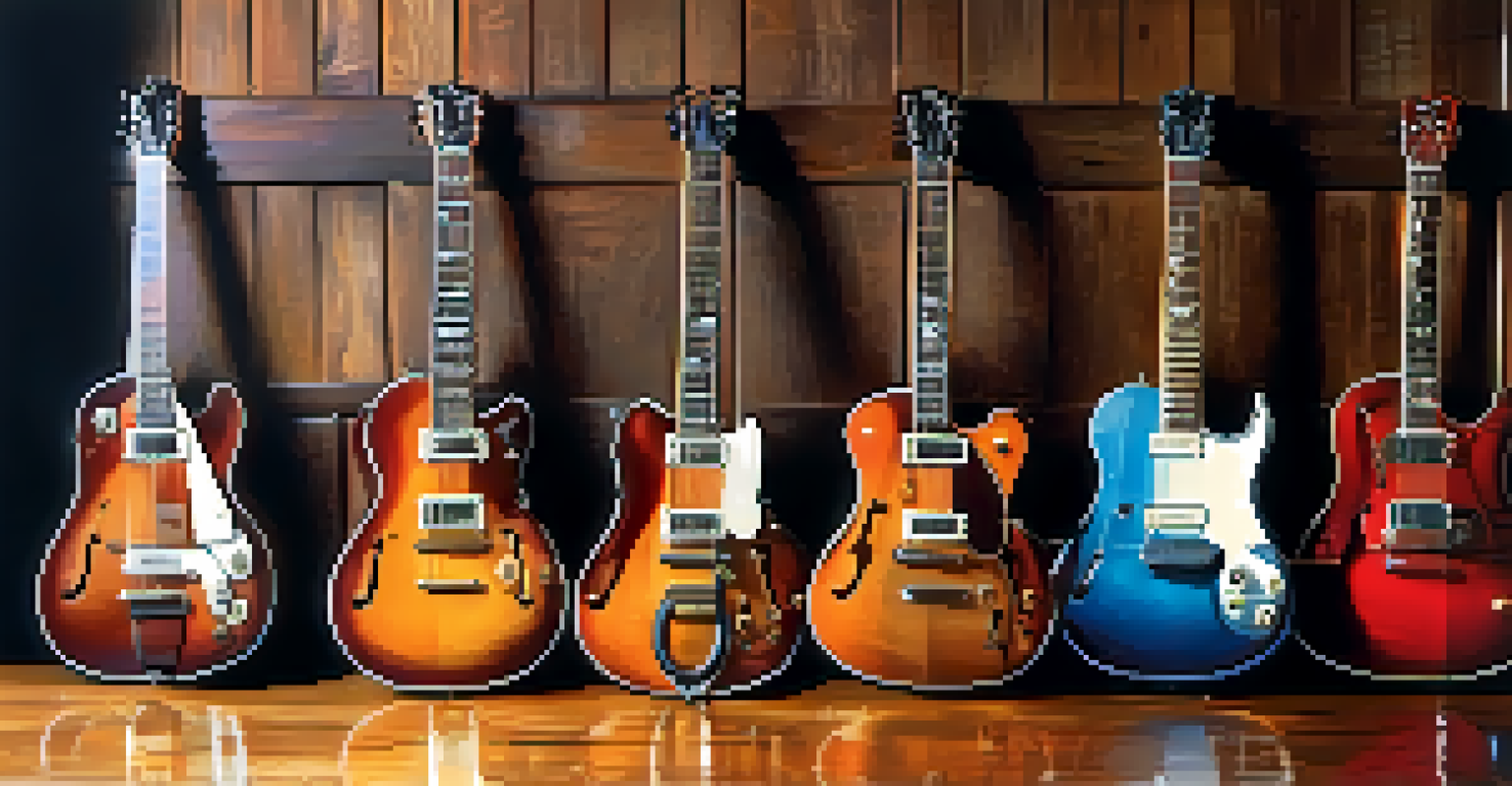The Role of Alternate Tunings in Slide Guitar Techniques

Understanding Slide Guitar and Its Unique Sound
Slide guitar is a mesmerizing technique that adds a vocal-like quality to music. By using a slide—often a glass or metal tube—players can create smooth glissandos and expressive bends that are hard to achieve with regular finger positioning. This technique is prevalent in various genres, from blues to country, and it offers a distinct emotional depth.
Music is the shorthand of emotion.
The sound of slide guitar often evokes feelings of nostalgia and longing, making it a favorite among many musicians. Its unique tonality allows for a more personal expression, as each note can be shaped and manipulated in real-time. This expressiveness is one reason why slide guitarists often explore various tunings.
Alternate tunings play a crucial role in enhancing the slide guitar experience. By changing the pitch of the strings, musicians can unlock new sonic possibilities and create different emotional landscapes, making it a fundamental technique for slide guitarists.
What Are Alternate Tunings? A Quick Overview
Alternate tunings involve tuning the strings of a guitar to pitches other than the standard EADGBE configuration. This opens up a world of creative opportunities, allowing players to explore different chord voicings, scales, and fingerings. It's like having a new palette of colors to paint with, giving musicians the freedom to express themselves in unique ways.

For slide guitar, alternate tunings can simplify finger positions and create more resonant chords. For instance, tuning to open G (DGDGBD) allows for easy access to major chords with just one finger while using the slide. This makes it particularly appealing for beginners or those looking to expand their playing style.
Slide Guitar's Emotional Depth
Slide guitar techniques create a vocal-like quality that adds emotional resonance to music.
Additionally, different tunings can enhance the drone-like qualities of slide guitar, which is often a hallmark of traditional music genres. By experimenting with various tunings, players can find their unique sound, elevating their musical expression.
Popular Alternate Tunings for Slide Guitarists
Some of the most popular alternate tunings for slide guitar include open G, open D, and C6. Each tuning offers distinct advantages and shapes the way musicians approach their instrument. For example, open D tuning (DADF#AD) is favored for its rich harmonic possibilities, allowing for a fuller sound when played with a slide.
The guitar is a miniature orchestra in itself.
Another favorite among slide guitarists is the open E tuning (EBEG#BE), which translates beautifully for blues and rock genres. This tuning allows players to achieve a bright, resonant sound that complements the emotional intensity of slide playing.
By familiarizing themselves with these tunings, musicians can expand their repertoire and experiment with different styles. Each tuning brings its own character to the music, making it an exciting journey of discovery.
How Alternate Tunings Influence Slide Techniques
Alternate tunings significantly influence the way slide guitar techniques are executed. By adjusting the string pitches, players can create unique finger placements that enhance their playing style. This means that familiar techniques, like hammer-ons and pull-offs, can take on a new dimension depending on the tuning chosen.
For instance, in open G tuning, players can easily perform rolling licks and melodic runs with minimal finger movement. This accessibility makes it easier to focus on expression and emotive playing rather than being bogged down by complex fingerings.
The Power of Alternate Tunings
Alternate tunings unlock new sonic possibilities, allowing musicians to explore unique chords and expressions.
Moreover, the resonant quality of certain tunings can inspire creative improvisation. Guitarists may find themselves playing differently than they would in standard tuning, leading to the discovery of new riffs and melodies that reflect their personal voice.
The Emotional Impact of Alternate Tunings
One of the most compelling reasons musicians choose alternate tunings is the emotional impact they can have on a piece. Different tunings evoke different feelings; for example, open D tuning often brings a sense of warmth and nostalgia. This emotional resonance can deeply connect listeners to the music, making the performance more memorable.
Slide guitar, combined with alternate tunings, can express a wide range of emotions, from melancholy to joy. The ability to bend notes and create fluid transitions allows musicians to tell stories through their instrument, captivating audiences in the process.
Furthermore, alternate tunings can inspire a sense of freedom and exploration. Musicians may find themselves venturing beyond their usual boundaries, leading to innovative compositions and heartfelt performances.
Learning to Use Alternate Tunings Effectively
For those looking to incorporate alternate tunings into their slide guitar playing, starting with one or two tunings is essential. Open G and open D are great starting points, as they offer immediate rewards without overwhelming the player. Practicing simple melodies and chords in these tunings can help build confidence and familiarity.
It's beneficial to listen to recordings of accomplished slide guitarists who utilize alternate tunings. This exposure can provide inspiration and a deeper understanding of how these tunings enhance musical expression. By analyzing their techniques, players can begin to integrate similar ideas into their own practice.
Techniques Enhanced by Tuning
Different tunings influence slide techniques, making it easier for players to focus on expression and creativity.
Finally, patience and experimentation are key. Every guitarist develops their style over time, and finding the right alternate tunings that resonate personally can lead to a fulfilling musical journey.
Final Thoughts on Alternate Tunings and Slide Guitar
In conclusion, alternate tunings play a pivotal role in the world of slide guitar. They not only offer technical advantages but also open up new emotional avenues for expression. By experimenting with different tunings, musicians can discover their unique voice and enhance their overall playing experience.
As you embark on this journey, remember that each tuning has its own character and can drastically change the way you approach music. Embracing alternate tunings can lead to exciting discoveries and personal growth as a guitarist.

So, whether you're a seasoned player or just starting, don't shy away from exploring alternate tunings. They might just unlock a whole new world of creativity and expression in your slide guitar playing.